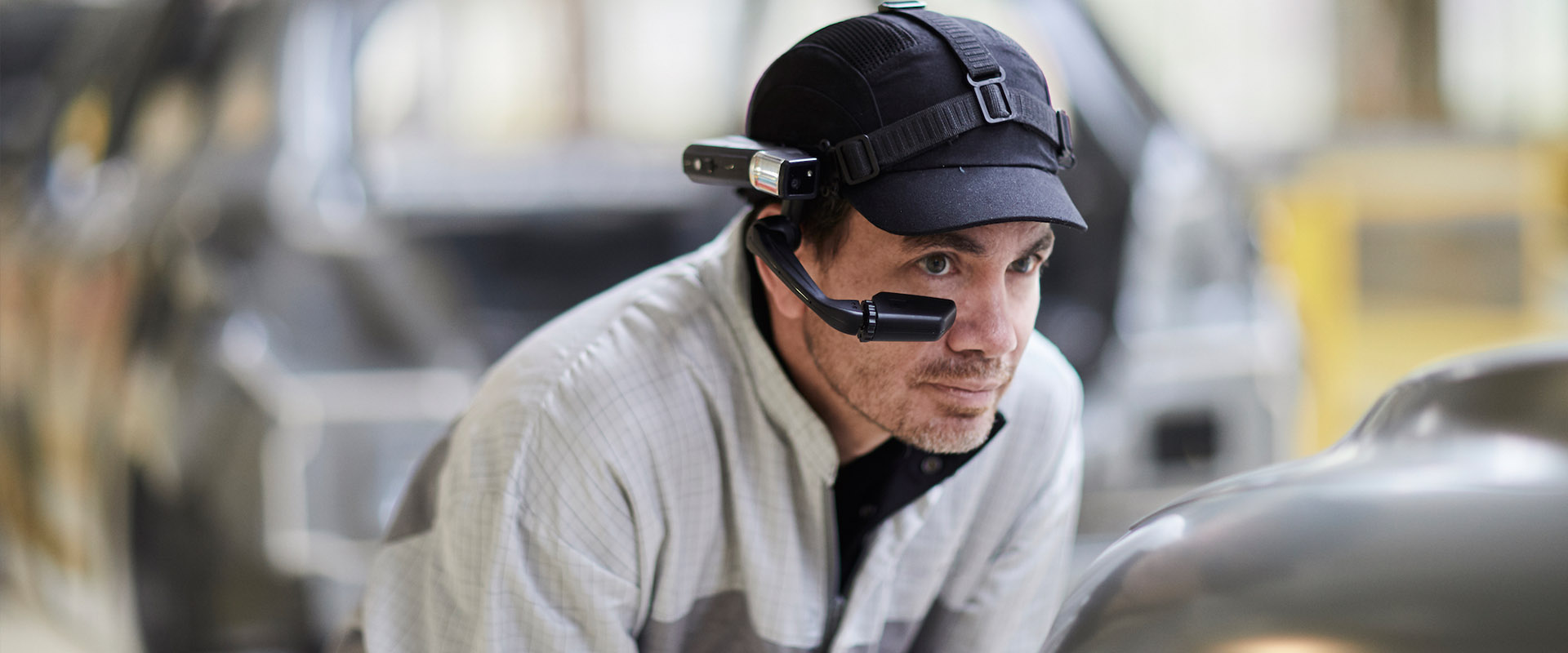INDUSTRY AND ENTERPRISE SHAPING FUTURE OF AR


Introduction:
Industry and enterprise play a vital role in driving the future of AR, advancing its adoption and innovations. By seamlessly merging the digital and physical realms, AR is poised to transcend boundaries.
It ushers us into a future where immersive experiences, enhanced productivity, and innovative collaborations become the norm. Furthermore, AR is revolutionizing training practices by creating immersive learning environments and bridging the skills gap.
In terms of customer experience, AR is redefining engagement in sectors such as retail, tourism, and entertainment through personalized and immersive encounters. The future of AR relies on collaborative efforts, innovation, and integration with emerging technologies like AI and IoT. By embracing AR, industries, and enterprises can gain a competitive edge and deliver immersive experiences.
Overall, the future of AR promises a seamless blend of digital and physical realms, unlocking endless possibilities in how we work, learn, and interact.
Enhancing Workforce Productivity and Efficiency:
The impact of AR on workforce productivity and efficiency cannot be overstated. Industry and enterprise have recognized the immense value of AR applications in providing real-time information, instructions, and guidance to workers.
The future of AR holds promise as enterprises embrace wearable AR devices like smart glasses and leverage AR applications on smartphones or tablets. These devices enable employees to access crucial data and tap into expert knowledge instantly, empowering them to perform complex tasks with heightened accuracy and precision.
The seamless integration of digital information and physical environments facilitated by AR is revolutionizing industries such as manufacturing, logistics, healthcare, and construction.
In the future of AR, we envision a workforce equipped with AR-enabled devices that allow workers to visualize digital overlays and instructions directly in their field of view. This eliminates the need for constant referencing of manuals or documentation, enhancing decision-making capabilities and streamlining operations.
The future holds exciting possibilities for industries to optimize work processes by harnessing the power of AR, resulting in improved efficiency and productivity across sectors.
Furthermore, the future of AR encompasses the remote assistance capabilities it offers. This aspect becomes increasingly valuable as experts can guide and support field workers in real-time, transcending physical limitations.
Regardless of their geographical location, experts can provide immediate guidance, minimizing errors and reducing downtime. The collaborative potential of remote assistance through AR empowers enterprises to enhance workforce productivity and efficiency to unprecedented levels.
Looking ahead, the future of AR will witness further advancements in both hardware and software. Wearable AR devices will become more sophisticated, lightweight, and ergonomically designed, ensuring optimal user experience and facilitating seamless integration into work routines.
With consistent advancement, undertakings will approach state-of-the-art apparatuses that empower labourers to play out their errands with improved capacities and effectiveness.
As what’s to come unfurls, we can anticipate that AR should turn into a fundamental piece of work schedules across businesses, with its effect on labour force efficiency and productivity arriving at new levels.
The coordination of AR into day-to-day activities will turn out to be more far-reaching, driving an extraordinary change in how undertakings are performed and how labourers communicate with their current circumstances. This evolution will result in optimized productivity, reduced inefficiencies, and empowered workforces capable of achieving exceptional results.
Transforming Training and Skill Development:
The future of AR holds tremendous promise in transforming training and skill development practices across industries. Traditional training methods often fall short when providing practical, hands-on experience, but AR emerges as a game-changer by creating immersive and interactive learning environments.
AR empowers trainees to engage in simulated real-world scenarios, enabling them to practice complex procedures and gain invaluable experience within a controlled, risk-free setting. The ability to overlay virtual objects or information onto physical surroundings amplifies the learning experience, making it more engaging, effective, and impactful. As a result, trainees can actively participate in interactive simulations that closely mimic real-world challenges and scenarios.
For instance, in the medical field, AR allows aspiring surgeons to practice intricate surgical procedures on virtual patients, honing their skills and gaining confidence before performing the procedures on actual patients. Similarly, engineers can leverage AR to visualize and interact with complex machinery, enabling them to grasp intricate details and understand the inner workings before working with the physical equipment.
The integration of AR in training programs enhances the onboarding process, accelerates skill development, and closes the skills gap more efficiently.
By embracing AR in training initiatives, industry and enterprise can foster a highly skilled workforce equipped to tackle the demands of a rapidly evolving technological landscape. The future of AR-driven training holds immense potential in upskilling individuals and preparing them for the complexities of their respective industries.
The interactive and immersive nature of AR training programs cultivates a deep understanding of tasks, procedures, and operations, empowering individuals to perform with confidence and proficiency.
Moreover, the future of AR in training extends beyond individual skill development. Collaborative AR experiences can facilitate teamwork and cooperation, allowing trainees to work together in virtual environments to solve complex problems or practice coordination in high-stakes scenarios. This collaborative element nurtures effective communication, critical thinking, and problem-solving skills, making AR an invaluable tool for team-based training and skill development. As we look towards the future, the integration of AR in training and skill development will continue to evolve.
Advancements in AR hardware and software will provide even more immersive and realistic experiences, further enhancing the effectiveness of training programs.
Learn more about how AR can help Industrial Workers here.
Revolutionizing Customer Experience:
AR’s impact extends far beyond the workplace and into the realm of customer experience. Industries such as retail, tourism, and entertainment are leveraging AR to provide unique and immersive experiences to their customers.
In the realm of retail, AR is redefining the shopping experience by enabling customers to visualize products in their environments before making a purchase. Through AR-enabled mobile applications, shoppers can virtually place furniture in their living rooms, try on clothing or accessories, or explore different product variations. This immersive visualization capability empowers customers to make more informed decisions and enhances their overall shopping experience.
In the tourism industry, AR enhances sightseeing experiences by overlaying historical information, augmented tour guides, or 3D visualizations onto real-world landmarks.
Additionally, AR is transforming entertainment and gaming by enabling users to engage in interactive experiences, blending the digital and physical worlds seamlessly. The integration of AR in customer-centric industries is revolutionizing how businesses engage with their customers, fostering deeper connections and providing personalized, immersive encounters that leave a lasting impression.
Driving Innovation and Collaboration:
Industry and enterprise are vital in driving the advancement and coordinated effort fundamental to the fate of AR. Organizations across areas are putting vigorously in innovative work to further develop AR equipment, programming, and UIs. Progressions in show advancements, for example, waveguide-based optical frameworks, are making AR gadgets more minimal, lightweight, and outwardly engaging.
Besides, the integration of AR with other arising advancements, like man-made brainpower (computer-based intelligence), AI, and the Web of Things (IoT), is opening new outskirts and use cases. Man-made intelligence-controlled algorithms are improving AR’s capacity to comprehend and decipher the actual climate, empowering more exact item acknowledgement, spatial planning, and motion acknowledgement. This combination of advancements is filling development and setting out new open doors for industry and endeavour to investigate.
Cooperation inside the business is additionally pivotal for the development and advancement of AR. By sharing best practices, exchanging knowledge, and setting common standards, businesses can collectively overcome challenges and drive the widespread adoption of AR. Collaborative efforts can foster the growth of AR ecosystems, comprising hardware manufacturers, software developers, content creators, and end-users.
Such ecosystems enable the exchange of ideas, promote interoperability, and encourage the creation of compelling AR experiences across multiple platforms and industries.
Conclusion:
Industry and enterprise hold the keys to shaping the future of AR. Businesses are propelling AR toward new horizons by enhancing workforce productivity, revolutionizing training practices, transforming customer experiences, and fostering collaborative innovation.
The future will see AR seamlessly integrated into various sectors, blurring the lines between the physical and digital realms. By embracing this transformative technology, industry and enterprise can gain a competitive edge, improve operational efficiency, and deliver immersive experiences to customers.
Through continued investment and collaboration, the future of AR will unlock endless possibilities, forever changing the way we work, learn, and interact with the world around us.

